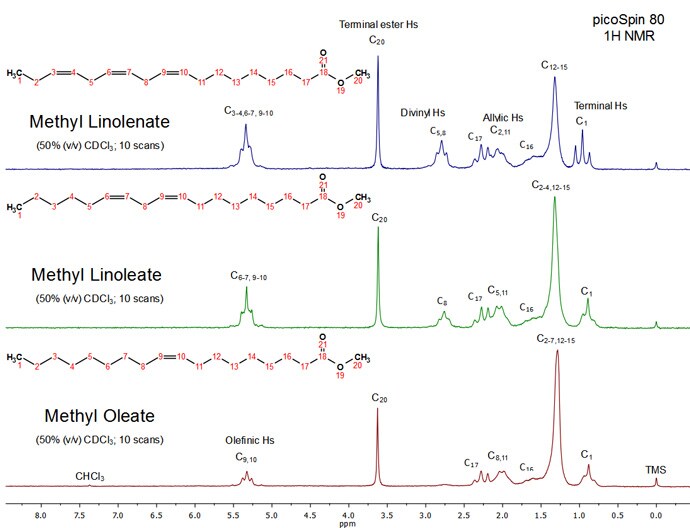Search Thermo Fisher Scientific
NMR Tech Talk: January 2015

In this issue
Methyl oleate (C19H36O2), methyl linoleate (C19H34O2) and methyl linolenate (C19H32O2) represent methyl esters of C18 essential fatty acids oleic acid (omega-9), linoleic acid (omega-6) and alpha-linoleic acid (omega-3), respectively. A fatty acid is a carboxylic acid with a saturated of unsaturated aliphatic chain. Fatty acid methyl esters (FAMEs) are compounds derived from transesterification of lipids, such as triglycerides, and which forms the foundation of the biodiesel industry.
The 1H NMR spectra were acquired at 82 MHz using the Thermo Scientific picoSpin 80 spectrometer.
The spectra of these three FAMEs show similar spectral behavior, varying mostly only in the relative intensities of signals. Structurally these compounds differ only in their degree of unsaturation due to the change in number of double bonds contained along the aliphatic chain. Methyl oleate, an 18:1 cis-9, or omega-9 FAME, contains one vinyl group located at position C9, methyl linoleate contains two vinyl groups (18:2 cis-6,9; omega-6) at positions C6 and C9, while methyl linolenate contains three vinyl groups (18:3 cis-3,6,9; omega-3) at positions C3, C6 and C9. As the number of double bonds increases so too does the associated NMR signal. Here, double bonds are not conjugated along the carbon backbone, but instead are separated by a methylene bridge (-CH2-). In spectra from methyl linoleate and methyl linolenate these bridging, or divinyl protons, are easily recognizable as their chemical shift position is downfield of aliphatic and allylic proton signals, offering a unique chemical signature that can be used to characterize the nature of the system.
High resolution 1H (82 MHz) spectra of structurally similar C18 FAMEs acquired with the picoSpin 80 spectrometer provides useful information for process flow characterization and quantification, demonstrating the power of NMR spectroscopy in a compact and affordable instrument. Factory conditions may not always be ideal for delicate instruments. With the picoSpin 80 flexibility, portability, and reliability matter just as much as the quality of an NMR spectrum. Its rugged construction, light weight, and size allows for easy placement next to a process flow, reactor or close by in the same lab.
FAMEs in biofuel production derive from a variety of natural oil feedstocks as well as renewable and waste-stream feedstocks to produce first-, second- and third-generation biofuels. Sources of FAME production include vegetable oils (e.g., rapeseed, soybean, palm), animal (e.g., tallow, lard, yellow grease), algae and sewage sludge, and as a by-product of omega-3 fatty acid production from fish oil. While all three are classified as biodiesel, they also have application in emulsifiers, solvents, oiling agents, and as raw material in varied other industries such as cosmetics and household care industries, textile and food industries, and pesticide, plastics and printing industries.
Chemical name: Methyl oleate (C19H36O2), methyl linoleate (C19H34O2) and methyl linolenate (C19H32O2) Experimental conditions: 10 scans
Concentration: 50% (v / v) in CHCl3
CAS number: 112-62-9 (methyl oleate), 112-63-0 (methyl linoleate), 301-00-8 (methyl linolenate)
Field: 82 MHz
Nuclear testing: 1H
Applications: Process analysis, QA / QC, productivity, biofuel

About NMR Tech Talk
Featuring the latest news, events, and educational approaches in benchtop NMR, Tech Talk is your forum for bringing this interesting and valuable technique into the classroom or as part of your analytical laboratory. Discover what's new from peers and from our experts at Thermo Fisher Scientific.
Spectroscopy, Elemental & Isotope Analysis Resource Library
Access a targeted collection of application notes, case studies, videos, webinars and white papers covering a range of applications for Fourier transform infrared (FTIR) spectroscopy, near infrared spectroscopy, Raman spectroscopy, nuclear magnetic resonance, ultraviolet-visible (UV-Vis) spectrophotometry, X-ray fluorescence, and more.
